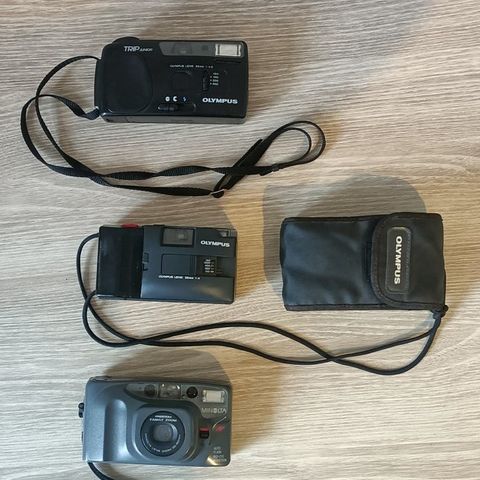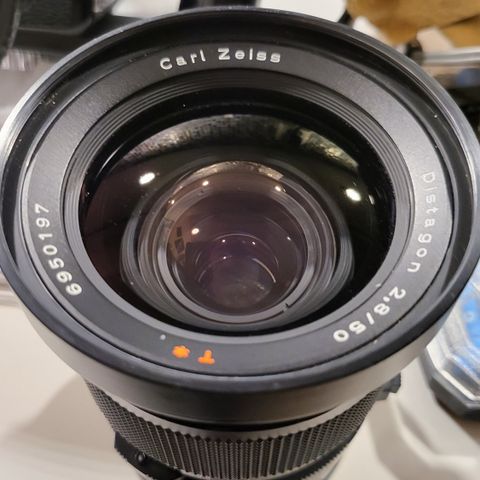Bildegalleri
Nikon FTZ adapter & Canon til Sony (Sigma MC-11)
Beskrivelse av varen
Pent brukt. Selges som på bildene. Norges billigste! Ny pris er rundt 3000, pr stk.
Sigma MC-11 : 990 (Canon EF til Sony E) Solgt
Nikon FTZ : 1290
The FTZ and FTZ II are the same, except that the FTZ II has no tripod foot so it's easier to use with the Z9's large grip. Otherwise these are the same adapters and I won't mention any more about one versus the other; they each work exactly the same as the other.
The Nikon FTZ and FTZ II are lens mount adapters that let us use any F-Mount Nikon SLR or DSLR lens with varying extents of usefulness on Nikon's full-frame mirrorless cameras.
FTZ means F to Z, or Nikon F (SLR & DSLR) mount to Nikon's new mirrorless Z mount.
The adapter only works properly (autofocuses) with Nikon's newest lenses, which are those with built-in AF motors (AF-I, AF-S and AF-P). With all other lenses autofocus does not work. AF and AF‑D lenses become manual focus only.
Nikon Z-mount (stylised as
Z
{\displaystyle \mathbb {Z} }) is an interchangeable lens mount developed by Nikon for its mirrorless digital cameras. In late 2018, Nikon released two cameras that use this mount, the full-frame Nikon Z7 and Nikon Z6. In late 2019 Nikon announced their first Z-mount camera with an APS-C sensor, the Nikon Z50. In July 2020 the entry-level full-frame Z5 was introduced. In October 2020, Nikon announced the Nikon Z6II and Nikon Z7II, which succeed the Z6 and Z7, respectively. The APS-C lineup was expanded in July 2021, with the introduction of the retro styled Nikon Zfc, and in October 2021, Nikon unveiled the Nikon Z9, which effectively succeeds the brand's flagship D6 DSLR.[1] The APS-C lineup was further expanded with the Nikon Z30, announced at the end of June 2022.[2] The Nikon Z6III was announced in June 2024.[3]
Nikon Z-mount
Type
Bayonet
Inner diameter
55 mm Sony a7iv a7riii a7riv a7riv a9ii a9iii a1 a7iii
Tabs
4
Flange
16 mm
Connectors
11 electrical pins
Introduced
2018 Skip to AF lenses starting at:
8-9mm 10-11mm 12mm 14mm 15mm 16mm
17mm 18mm 19mm 20mm 24-25mm 28mm
35-40mm 50 & 58mm 55mm 60mm 70-75mm
80mm 85mm 100-105mm 120-150mm
180mm 200mm 300mm 400mm 500mm
600mm 800mm Teleconverters
1.4 2.8 f2 f2.8 f4 1.2 1.8
Nikon Z 6 showing wide-diameter lens mount and full-frame sensor
Nikon SLR cameras, both film and digital, have used the Nikon F-mount with its 44 mm diameter since 1959. The Z-mount has a 55 mm diameter. The FTZ lens adapter allows many F-mount lenses to be used on Z-mount cameras.[4] The FTZ allows AF-S, AF-P and AF-I lenses to autofocus on Z-mount cameras. The older screw-drive AF and AF-D lenses will not autofocus with the FTZ adapter, but they do retain metering and Exif data. Z-mount cameras support metering as well as in-body image stabilization (IBIS) with manual focus lenses.
The 55 mm throat diameter of the Nikon Z-mount makes it the largest full-frame lens mount.[5][6] It is much larger than the F-mount and the E-mount used by Sony mirrorless cameras[7] but only slightly larger than the 54 mm of both the Canon EF and RF mounts. It is also slightly larger than the 51.6 mm diameter full-frame mirrorless Leica L-Mount.[8] The Z-mount has also a very short flange distance of 16 mm,[9] which is shorter than all mentioned lens mounts. This flange distance allows for numerous lenses of nearly all other current and previous mounts to be mounted to Z-mount with an adapter.
The Z-mount 58 mm f/0.95 S Noct lens reintroduced the Noct brand historically used by Nikon for lenses with ultra-fast maximum apertures.[10][11]
Nikon published a roadmap outlining which lenses are forthcoming when the Z-mount system was initially announced.[12] The roadmap has been updated multiple times.[13] As of November 2023 the current version of the roadmap indicates a 35 mm lens left to be released within 2023.[14][15]
Z-mount cameras
edit
Nikon Z9
Nikon Z9
Nikon Z8 + Z 24-120 mm f/4 S
Nikon Z8 + Z 24-120 mm f/4 S
Nikon Z6II
Nikon Z6II
Model Release year Sensor Cards Continuous fps Weight Video recording
Type Pixels IBIS 1080p 4K 6K 8K 10-bit 12-bit
Z30 2022 DX
(APS-C) 20.9 MP No SD 11 fps 405 g 120 fps 30 fps No No No No
Z50 2019 450 g
Zfc 2021 445 g
Z5 2020 FX
(full frame) 24.3 MP Yes 2× SD 4.5 fps 675 g 60 fps 30 fps, 1.7x crop[16] No No No No
Z6 2018 24.5 MP CFX 12 fps 675 g 120 fps 30 fps No No With
external
HDMI
recorder Paid
upgrade
with
compatible
recorders
only
Z6II 2020 CFX +
SD 14 fps 705 g 120 fps 30 fps
60 fps (1.5x crop)[17]
Z6III 2024 20 fps (RAW)
60 fps (JPEG)
120 fps (11 MP)
760 g 240 fps 60 fps
120 fps (1.5x crop)[18] 60 fps No Yes Yes
Z7 2018 45.7 MP CFX 9 fps 675 g 120 fps 30 fps No No With
external
HDMI
recorder Paid
upgrade
with
compatible
recorders
only
Z7II 2020 CFX +
SD 10 fps 705 g 120 fps 30 fps
60 fps (1.08x crop)[19]
Zf 2023 24.5 MP SD +
microSD 14 fps 710 g 120 fps 30 fps
60 fps (1.5x crop) No No Yes No
Z8 2023 FX
Stacked 45.7 MP CFX +
SD 20 fps (RAW)
30 fps (JPEG)
60 fps (19 MP)
120 fps (11 MP) 910 g 120 fps 120 fps No 60 fps Yes Yes
Z9 2021 2× CFX 1340 g
CFexpress slots are backwards-compatible to XQD cards.
The supported video frame rates are: 24/25/30 fps when up to 30 fps are supported, while cameras supporting up to 60 fps also support 50 fps recording. Cameras supporting up to 120 fps also support 100 fps recording. Cameras supporting 100/120 fps recording can also record in x4/x5 slow motion directly (targeting 24/25/30 fps video frame rates), which means playback of the resulting video file is already in slow motion, without the need for editing.
Apart from the Z30, Z8 and Z9,[needs update] all cameras have a 30-minute length limitation for internal recording. External recording time is only limited by battery life.
External 10-bit recording can optionally use N-Log, a profile for recording video. The Z6II and Z7II also support external recording of 10-bit hybrid log gamma (HLG) video.
For the Z6/7 and Z6II/7II, the extra-cost 12-bit upgrade enables external recording of 12-bit ProRes RAW.[20] The resulting footage has greater dynamic range than 8- or 10-bit footage. However, the camera uses pixel skipping (which is necessary since ProRes RAW directly stores non-debayered sensor data) resulting in a somewhat softer image with more noise and more frequent appearance of moiré patterns compared to the full-width downsampling 8- and 10-bit modes.[21] 0–9
Canon EF 14mm lens
Canon EF 17-40mm lens
Canon EF 20mm lens
Canon EF 20-35mm lens
Canon EF 24–70mm lens
Canon EF 24-105mm lens
Canon EF 200mm lens
Canon EF 28-80mm lens
Canon EF 28-90mm lens
Canon EF 28-105mm lens
Canon EF 28-200mm lens
Canon EF 28mm lens
Canon EF 35mm lens
Canon EF 38-76mm lens
Canon EF 40mm lens
Canon EF 55–200mm lens
Canon EF 70–200mm lens
Canon EF 70-300mm lens
Canon EF 80-200mm lens
Canon EF 85mm lens
Canon EF 100mm lens
Canon EF 100–200mm lens
Canon EF 100-300mm lens
Canon EF 180mm f/3.5L Macro USM lens
Canon EF 200-400mm lens
Canon EF 500mm lens
Canon EF 600mm lens
Canon EF 800mm lens
C
Canon EF 8-15mm lens
Canon EF 11–24mm lens
Canon EF 15mm lens
Canon EF 16-35mm lens
Canon EF 17-35mm lens
Canon EF 22-55mm lens
Canon EF 24-85mm lens
Canon EF 24mm lens
Canon EF 28-70mm lens
Canon EF 28-135mm lens
Canon EF 28-300mm lens
Canon EF 35-70mm lens
Canon EF 35–80mm lens
Canon EF 35–105mm lens
Canon EF 35-135mm lens
Canon EF 35–350mm lens
Canon EF 50-200mm lens
Canon EF 50mm lens
Canon EF 70–210mm lens
Canon EF 75–300mm lens
Canon EF 90–300mm lens
Canon EF 100-400mm lens
Canon EF 135mm lens
Canon EF 300mm lens
Canon EF 400mm lens
Canon EF 1200mm lens
Canon Extender EF
Canon TS-E 17mm lens
Canon TS-E 24mm lens
Canon TS-E 45mm lens
Canon TS-E 50mm lens
Canon TS-E 90mm lens
Canon TS-E 135mm lens
M
Du må være logget inn for å se brukerprofiler og sende meldinger.
Logg innAnnonsens metadata
Sist endret: 30.9.2024, 13:04 ・ FINN-kode: 372801742












